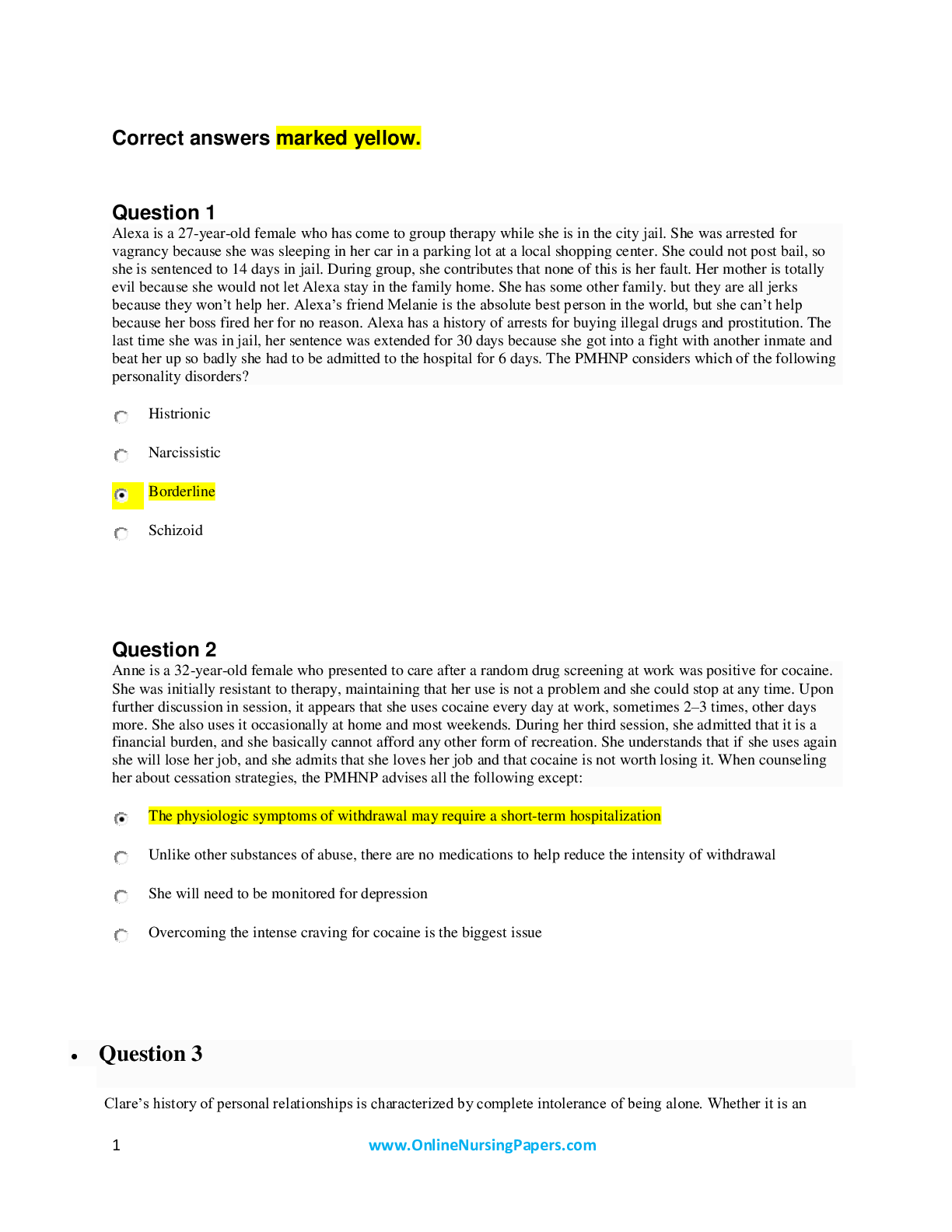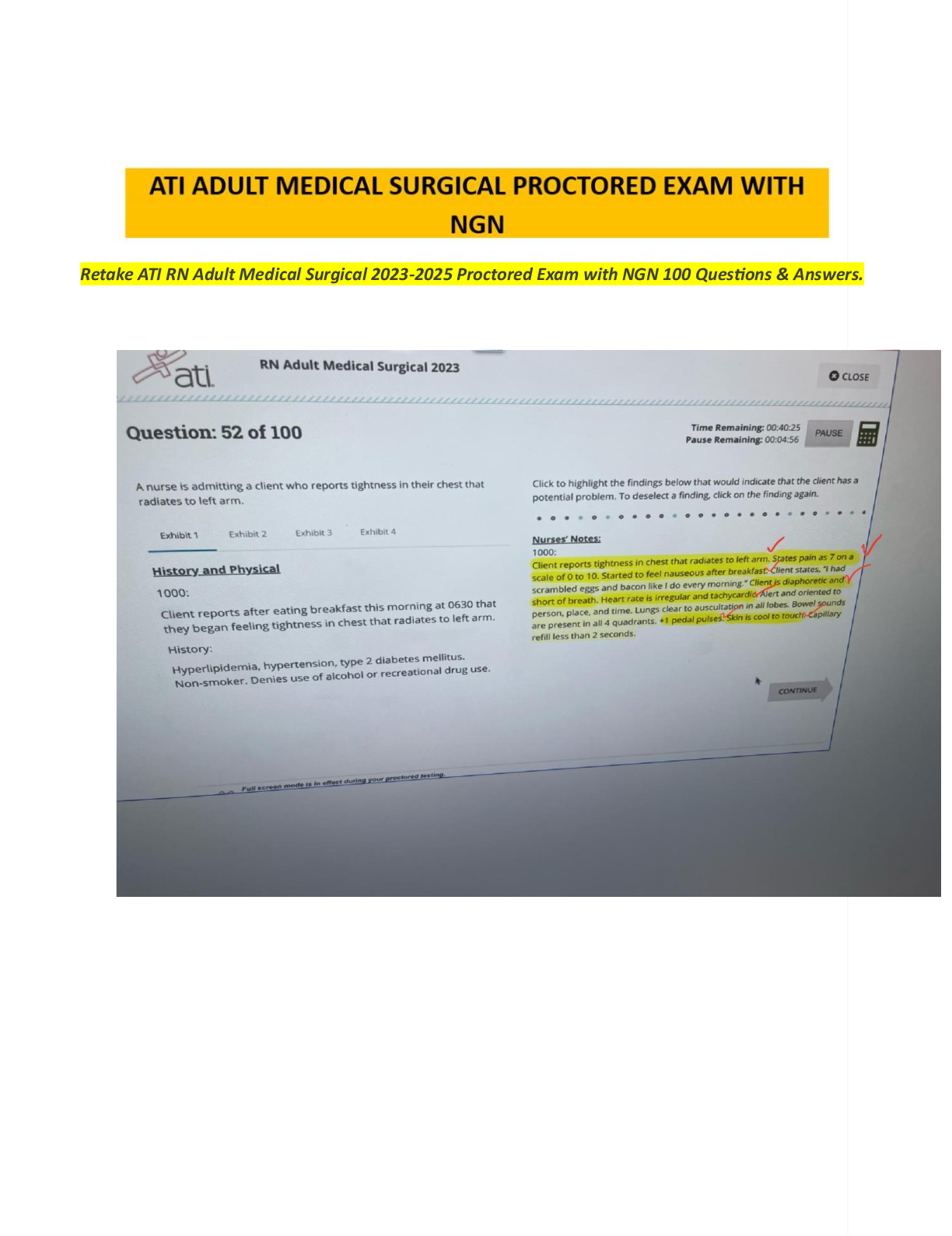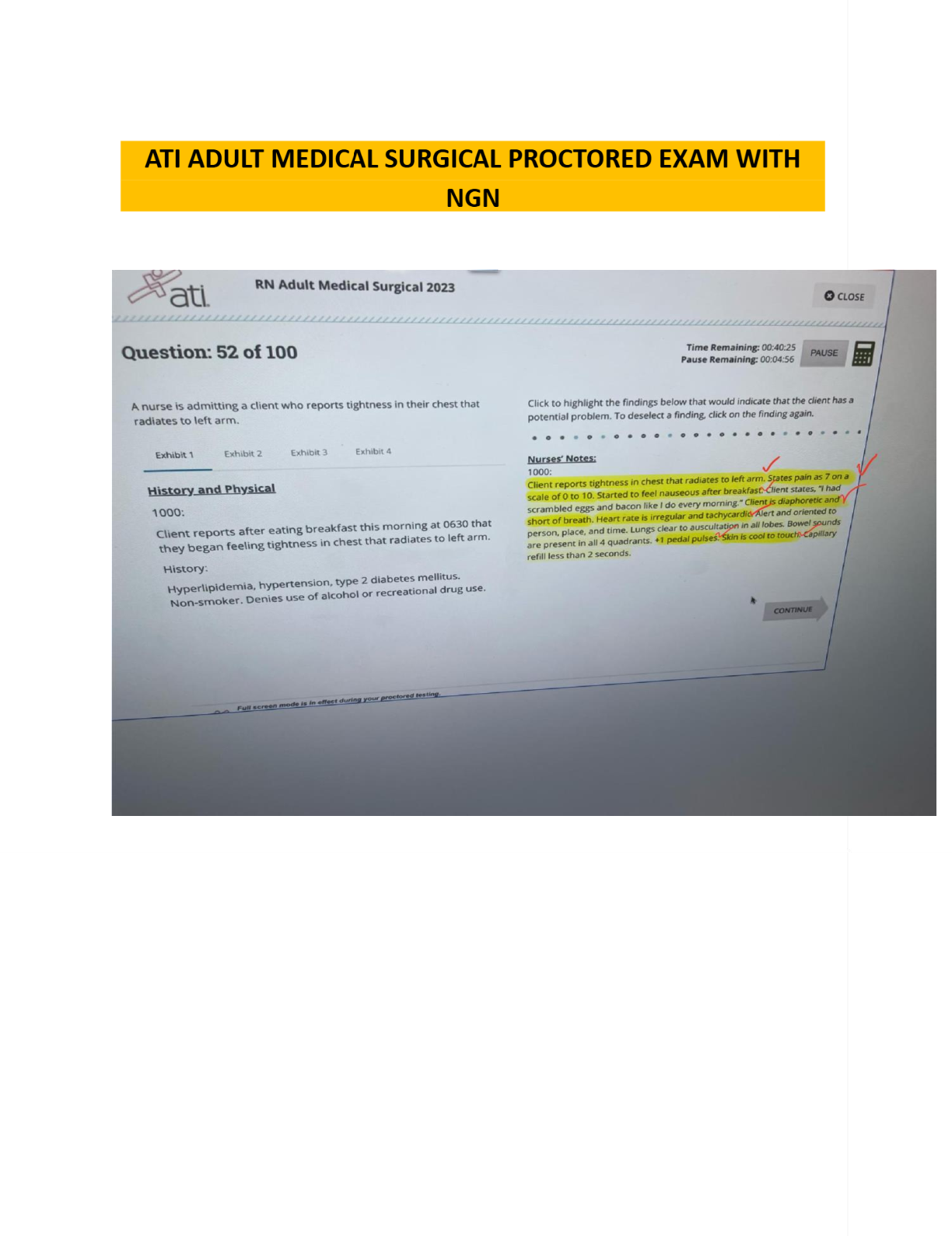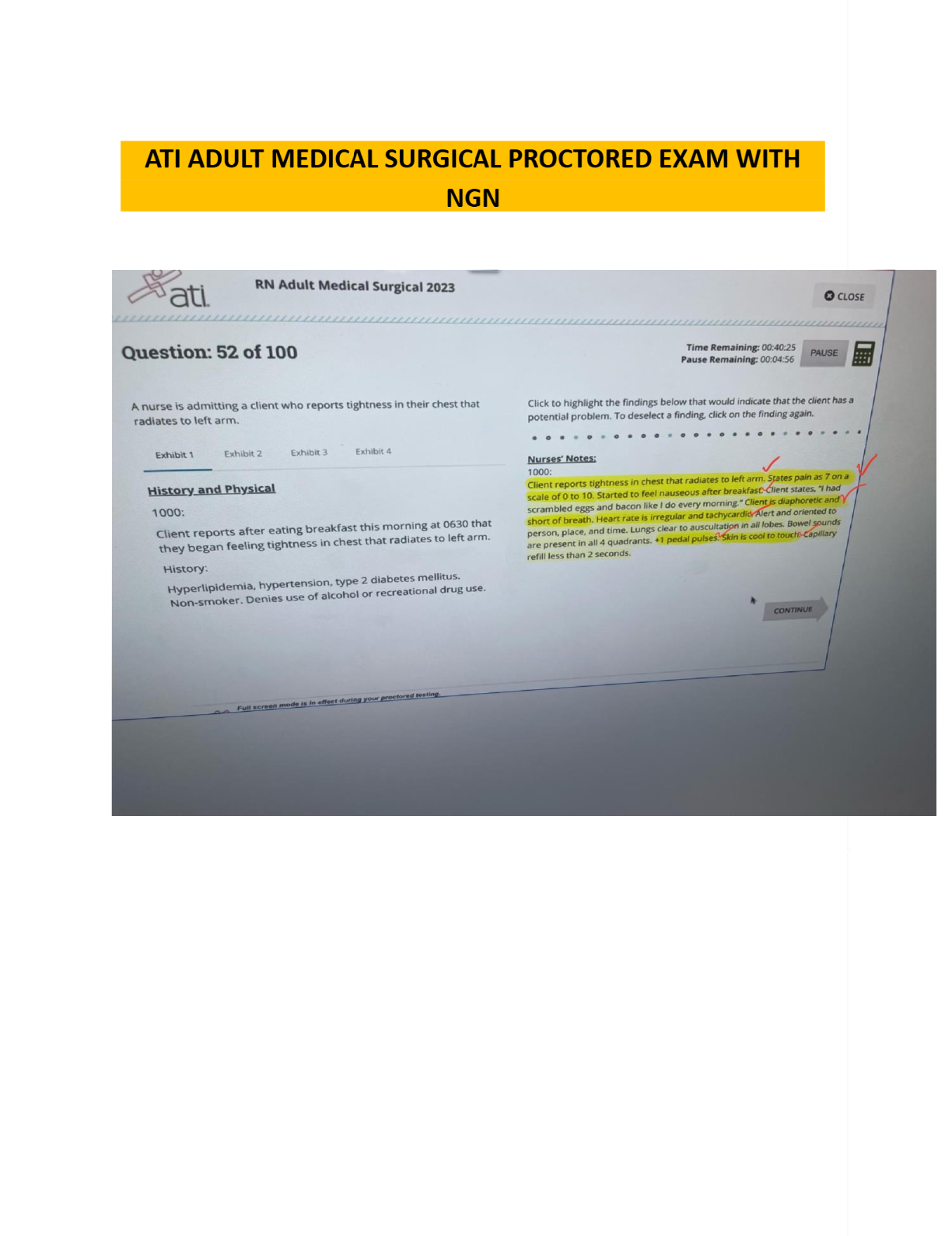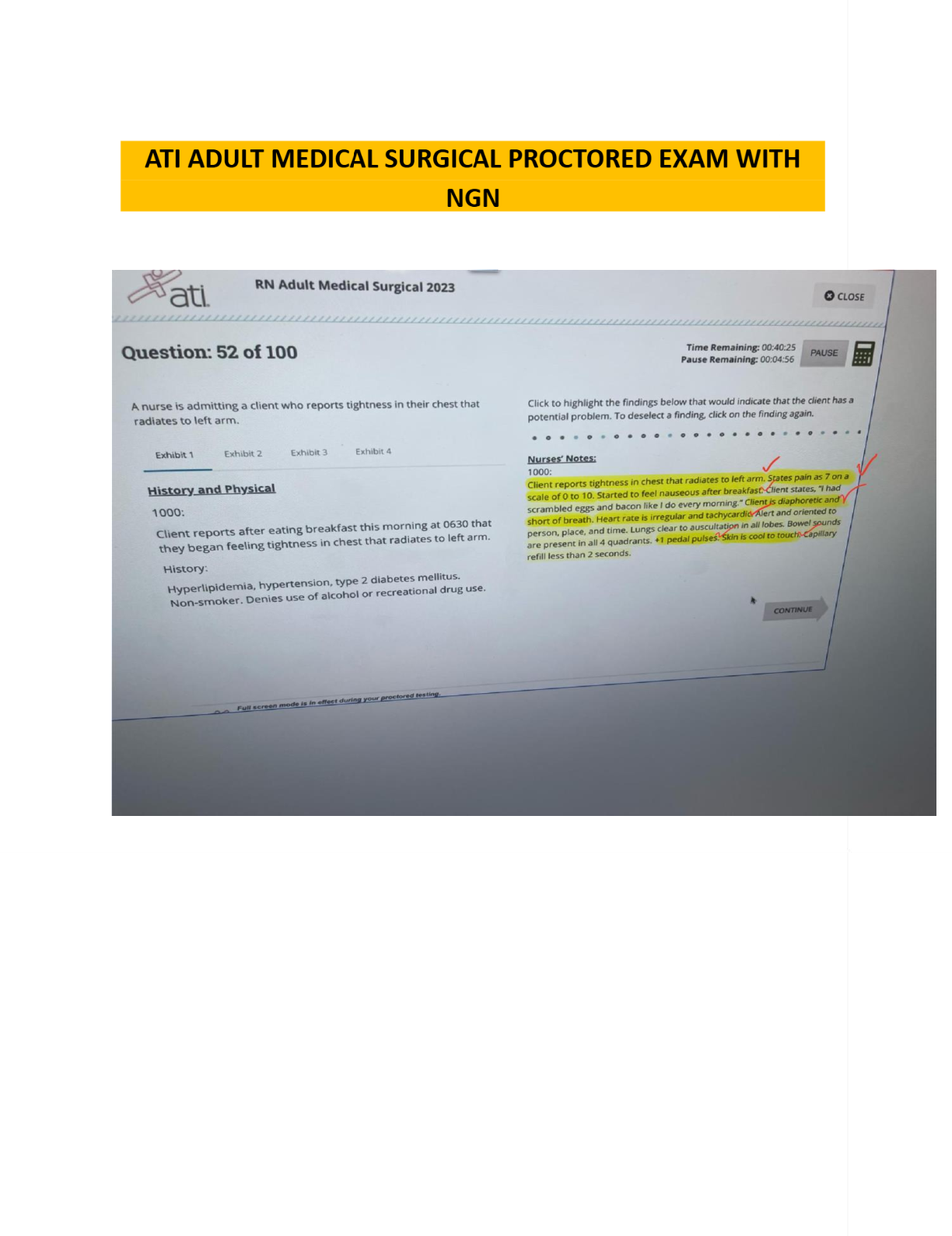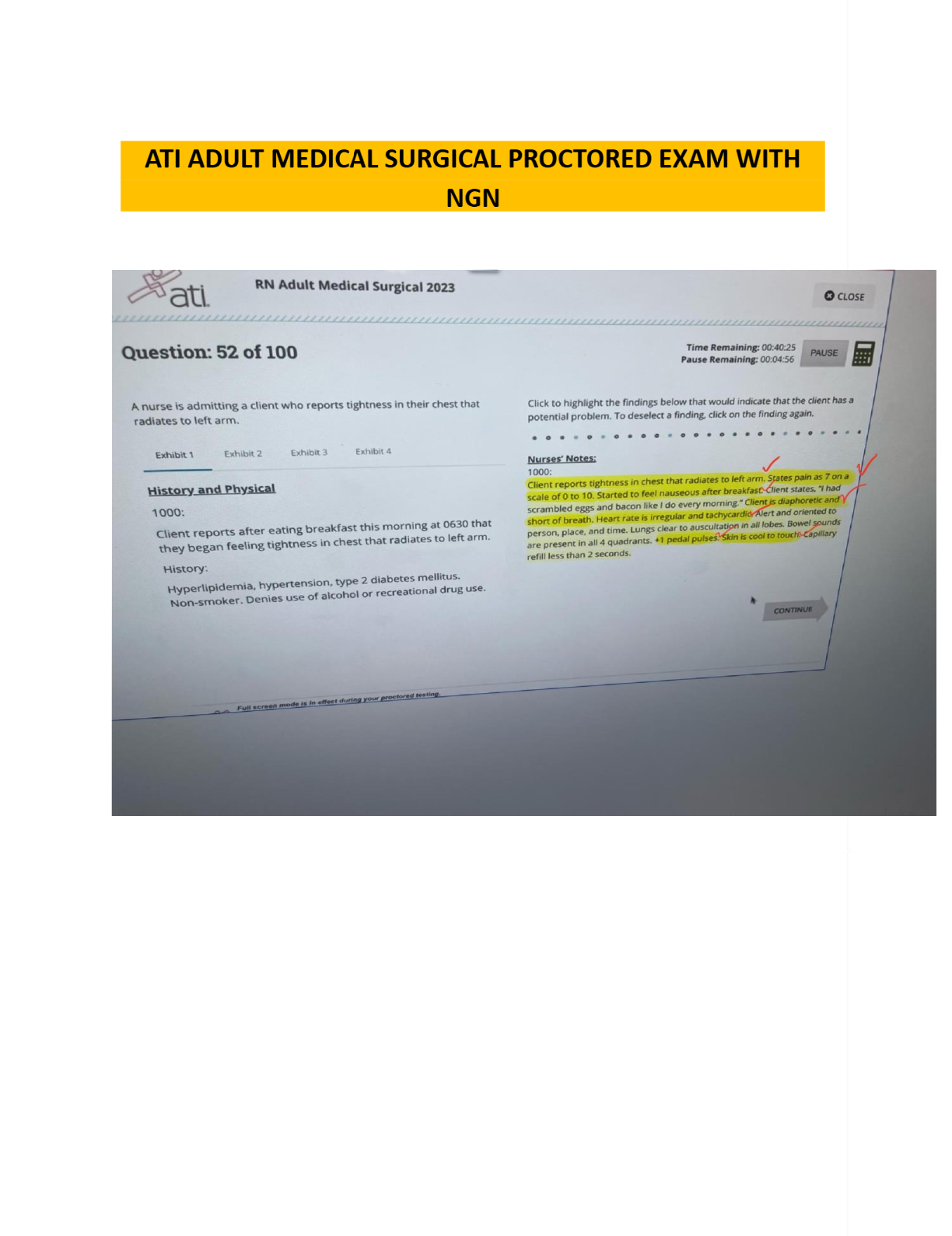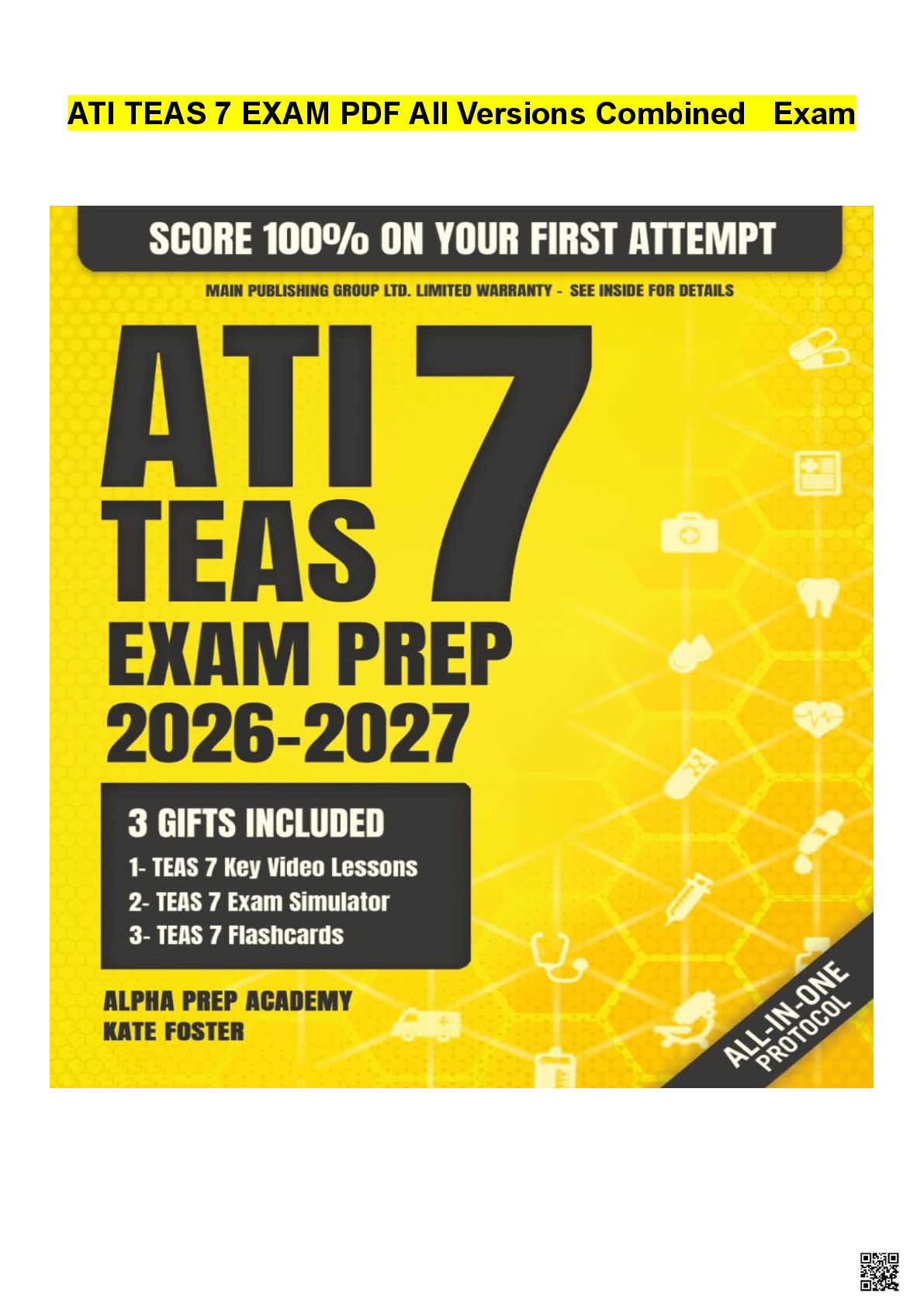RN Comprehensive Predictor Remediation EXAM DOCS 2021
Document Content and Description Below
RN Comprehensive Predictor Remediation EXAM DOCS 2021 Professional Responsibilities: Identifying Client Advocacy 1) Ensures the client has the information they need to make decisions about healthc ... are 2) Advocate even when they disagree with the client’s decision 3) Advocate when clients are unable to speak or act for themselves Managing Client Care: Action Requiring Intervention during Tracheostomy Suctioning 1) An open airway is necessary for breathing so it is the highest priority 2) Breathing is necessary for oxygenation of the blood to occur 3) Circulation is necessary for oxygenated blood to reach the body’s tissues Managing Client Care: Effective Time Management 1) Taking time to plan care and taking priorities into consideration 2) Making repeated trips to the supply room 3) Completing one task before beginning another task for equipment Coordinating Client Care: Planning Care for a Client Following a Stroke 1) Initiation revision and evaluations of the plan of care 2) Facilitating referrals and the use of community resources 3) Facility to another, such as from an acute care facility to a skilled facility Coordinating Client Care: Information to Report to Occupational Therapist 1) Client medical diagnosis and care providers 2) Overview of health status, plan of care, and recent progress 3) Most recent vital signs and medications Multiple Sclerosis: Priority Referral for a Client who has Amyotrophic Lateral Sclerosis 1) Plan for disease progression 2) Consider referral to occupational and physical therapy for home environment assessment to determine safety and ease of mobility. 3) Refer to speech language therapist for dysarthria and dysphagia. Information Technology: Using Correct Documentation 1) Begin each entry with the date and time 2) Record entries legibly, in nonerasable black ink, and do not leave blank spaces in the nurses’ notes 3) Sign all documentation as the facility requires, generally with name and title Professional Responsibilities: Priority Action When Obtaining a Signature on an Informed Consent Form 1) For an invasive procedure or surgery, the client is required to provide written consent 2) State laws regulate who is able to give informed consent 3) The nurse must verify that consent is informed and witness the client sign the consent form Communicable Diseases, Disasters, and Bioterrorism: Reportable Infectious Diseases 1) Tuberculosis 2) Hepatitis A 3) Hepatitis C Cultural and Spiritual Nursing Care: Communicating with a client who speaks a language different from the nurse 1) Nurses should accommodate each client’s cultural beliefs and values whenever possible, unless they are in direct conflict with essential health practices 2) Study the client and their environment for examples of cultural relevance 3) Use only a facility-approved medical interpreter Professional Responsibilities: Understanding Regulations for Nursing Scope of Practice 1) Nurses should refuse to practice beyond the legal scope of practice and/or outside of their areas of competence regardless of reason 2) Nurses should use the formal chain of command to verbalize concerns related to assignment in light of current legal scope of practice, job description, and area of competence 3) Standards of care guide, define, and direct the level of care that should be given by practicing nurses Medications Affecting Urinary Output: Teaching About Furosemide 1) Monitor blood pressure 2) Monitor electrolytes and weight 3) Report urine output less than 30 Ml/hr Musculoskeletal Trauma: Discharge Teaching Following Surgery for Carpal Tunnel Syndrome 1) Ensure the client is aware of application protocol regarding full-time or part-time use 2) Instruct the client to observe for skin breakdown at pressure points 3) Do not remove unless instructed to do so Cancer Treatment Options: Caring for a Client Who Has a Radiation implant 1) Place the client in a private room away from other clients when possible 2) Keep the door closed as much as possible 3) Place a sign on the door warning of the radiation source Medical and Surgical Asepsis: Maintaining Aseptic Technique 1) Perform hand hygiene before and after every client contact, and after removing gloves 2) Use protective clothing such as masks, gloves, gowns, and protective eyewear 3) Avoid coughing, sneezing, and talking directly over a sterile field Newborn Assessment: Expected Findings 1) Blood pressure should be 60 to 80 mm Hg systolic and 40 to 50 mm Hg diastolic 2) Normal heart rate ranges from 110 to 160/min with brief fluctuations above and below this range depending on activity level 3) Respiratory rate varies from 30 to 60 breaths/min with short periods of apnea occurring most frequently during the rapid eye movement sleep cycle Client Education: Creating Written Teaching Materials 1) Assess/monitor learning needs 2) Evaluate the learning environment 3) Identify learning style Health Promotion and Disease Prevention: Evaluating Understanding of Genetic Risks 1) Use stress management strategies 2) Get adequate sleep and rest 3) Avoid saturated fats Sources of Nutrition: Teaching About Food Sources of Calcium 1) Dairy 2) Kale 3) Egg Yolks Care of Specific Populations: Evaluating Health Risks of Migrant Farm workers 1) Climate caused illnesses 2) Communicable diseases 3) Bladder and kidney disorders Medications for Substance Use Disorders: Evaluating Teaching about Disulfram 1) Daily oral medication that is a type of aversion (behavioral therapy) 2) Wear medical adult bracelet 3) Used concurrently with alcohol will cause acetaldehyde syndrome Anxiety Disorders: Action for a client who is Experiencing a Panic Level of Anxiety 1) Structured environment for physical safety 2) Monitor for, and protection from, self-harm 3) Open-ended questions, to help the client express feelings of anxiety Anxiety Disorders: Planning Care for a client Who Has Obssessive-Compulsive Disorder 1) SSRI antidepressant, such as sertraline or paroxetine 2) Assess client risk for self-harm 3) Ensure client is provided with a safe environment Cultural, Ethnic, and Religious Influence: Food Selections for a Client Who Follows a Kosher Diet 1) Tuna 2) Herring 3) Salmon Effective Communication: Responding to a Client Who is Obese and Crying 1) Interactive, purposeful communication skills 2) Express empathy and genuine concern 3) Elicit and attend to a client’s thoughts, feelings, concerns, and need Psychotic Disorders: Caring for a Client who has Auditory Hallucinations 1) Ask directly about hallucinations 2) Should not argue or agree with the client’s view of the situation 3) Provide for safety, due to the increased risk for harm to self or others Sedative-Hypnotics: Identifying Antidote to Diazepam 1) Administer by oral route 2) Instruct clients to take medication 30 min prior to bedtime 3) Instruct clients to take medication on an empty stomach and to avoid high-fat foods before taking Substance Use and Addictive Disorders: Identifying Manifestations of Opiod Withdrawal 1) Diarhea 2) Insomnia 3) Pupil Dilation Effective Communication: Responding to a Client Who Has Major Depressive Disorder 1) Caring Attitude 2) Active listening 3) Eye contact Bowel Elimination: Assessing a Client Who Has an Ileostomy 1) Closely monitor fluid status and elimination pattern 2) Record food and fluid intake and output 3) Observe and document the character of bowel movements Postpartum Physiological Adaptations: Interventions to Promote Voiding 1) Encourage the client to empty her bladder frequently to prevent possible displacement of the uterus atony 2) Measure the client’s first few voiding after delivery to assess for bladder emptying 3) Encourage the client to increase her oral fluid intake to replace fluids lost at delivery and to prevent or correct dehydration Spinal Cord Injury: Planning Care to prevent skin breakdown 1) Maintain body alignment and ensure cervical tong weights hang freely 2) Monitor skin integrity by providing pin care and assessing the skin under the halo fixation vest as appropriate 3) Do not use halo device to turn or move client Benign Prostatic Hyperplasia: Identifying Medication Interactions with Saw Palmetto 1) Reinforce that it can take 6 months to 1 year before effects of the medication are evident 2) Inform the client that impotence and a decrease in libido are possible adverse effects 3) Advise the client to report breast enlargement to the provider Overview of Community Health Nursing: Identifying a Tertiary Prevention Strategy for Parkinson’s Disease 1) Referral to support groups that allow members to share strategies for living well 2) Have client to create a space they are familiar with 3) Have client to avoid multi-tasking while walking Pain Management: Promoting Comfort During a Heel Stick 1) Lidocaine and prilocaine is available in cream or gel for puncture 2) Place an occlusive dressing over the cream after application 3) Instruct parents to apply medication at home as well Burns: Supporting Nutritional Requirements 1) Increase caloric intake to meet increased metabolic demands and prevent hypoglycemia 2) Increase protein intake to prevent tissue breakdown and promote healing 3) Caloric needs double or triple 4 to 12 days after the burn Medications for Depressive Disorders: Food and Medication Interactions 1) Discontinue MAOI’s 14 days prior to starting an SSRI 2) Fluoxetine should be discontinued 5 weeks before starting an MAOI 3) Advise against concurrent use of TCA’s and St. John’s wort along with SSRI’s Nasogastric intubation and enteral feedings: Nursing actions for continuous enteral feeding 1) Prepare the formula, tubing, and infusion device 2) Assist the client to Fowler’s position, or elevate the head of the bed to a minimum of 30 degrees 3) Auscultate for bowel sounds Renal disorders: Teaching a client who has chronic kidney disease 1) Explain why dietary changes are necessary 2 )Provide support for the client and family 3) Caution clients to use vitamin and mineral supplements only when recommended by the provider Stroke: Assisting a client who has dysphagia 1) Assess gag reflex 2) Keep the client completely NPO until evaluated by SLP 3) If the client exhibits difficulty managing food or fluids, a swallowing evaluation should be done by SLP Home Safety: Home recommendations for a client who is postoperative 1) Remove items that could cause the client to trip, such as throw rugs and loose carpets 2) Place electrical cords and extension cords against a wall behind furniture 3) Use a nonskid mat in the tub or shower Rest and Sleep: Priority findings to report to the provider 1) Sleep patterns 2) Sudden attacks of sleep 3) Excessive sleepiness during waking hours Medications affecting coagulation: Medications contraindicated for use with warfarin 1) Aspirin 2) Acetaminophen 3) Sulfonamides Medications affecting urinary output: Identifying an adverse affect of furosemide 1) Monitor potassium levels regularly 2) Avoid salt substitutes that contain potassium 3) Self-monitor blood pressure Postpartum Disorders: Anticipating a provider prescription for postpartum hemorrhage 1) If client loses more than 500 mL blood after a vaginal birth 2) If client loses more than 1,000 mL blood after cesarean birth 3) Complications that can occur include hypovolemic and anemia Dosage Calculation: Calculating Rantidine IV dosage 1) Determine which method one would use ( ratio and proportion, formula, and dimensional analysis) 2) Determine the unit of measurement one should calculate such as capsules 3) Determine what dosage is available Dosage calculation: Liquid medication by weight 1) Determine the of unit measurement such as mL 2) Determine whether the units of measurement need converting 3) Reasses to determine whether the amount one is going to administer makes sense Adjuvant medications for pain: Client teaching about glucocorticoid therapy 1) Monitor potassium and cardiac rhythm 2) Encourage clients to eat potassium-rich foods 3) Administer potassium supplements Medications affecting blood pressure: Preparing to administer nitroprusside 1) Monitor blood pressure 2) Advise clients to rise slowly from sitting 3) Advise clients to avoid activities that require alertness until effects are known Safe medication Administration and Error reduction: Completing medication reconciliation during admission 1) Read medication labels and compare them with the MAR three times 2) Leave unit-dose medication in its package until administration 3) When using automated medication dispensing systems, perform the same checks and adapt them as necessary Acute infectious gastrointestinal disorders: Teaching about intermittent parenteral therapy 1) Obtain daily weights at the same time each day 2) Avoid taking a rectal temperature 3) Avoid antibiotics Fluid imbalances: Reportable findings 1) Hyponatremia 2) Hypokalemia 3) Hypocalcemia Kidney transplant: Laboratory values to report to the provider 1) Report hourly output volumes less than 30 mL/hr 2) Assist in monitoring urine output 3) Assist in blood loss Medications for bipolar disorders: Monitoring lithium levels 1) Administer new dosage based on serum lithium levels 2) Monitor for mental confusion, notify provider 3) Ongoing GI distress, notify provider Chest tube insertion and monitoring: Finding to report to the provider 1) Notify the provider if an air leak is noted 2) Report if tubing has kinks 3) Report if tubing has occlusions or loose connections Urinary elimination: Preventing urinary tract infection 1) Clean from front to back (Females) 2) Clean beneath the foreskin (Males) 3) Provide catheter care regularly Complications Of infants: Manifestations of dehydration 1) Give extra fluids in frequent, small sips, 2) Continue a regular diet 3) Provide parents with education and support Stroke: Manifestations of left hemisphere stroke 1) Monitor vital signs every 1 to 2 hrs 2) Monitor the client’s temperature 3) Institute seizure precautions Cancer disorders: Preoperative teaching for a client who is scheduled for a modified radical mastectomy 1) Teach the client how to care for her incision and drainage tubes 2) Advise client to avoid placing her arm in a dependent position 3) Teach the client not to wear constrictive clothing Acute and infectious respiratory illnesses: Caring for an infant who has respiratory syncytial virus 1) Closely monitor progression of illness and ensuing respiratory distress 2) Make emergency equipment for intubation readily accessible 3) Implement isolation precautions as indicated Assessment and management of newborn complications: Interventions for phototherapy 1) Perform ongoing assessment of the newborn using the neonatal abstinence scoring system assessment, as prescribed 2) Elicit and assess the newborn’s reflexes 3) Swaddle the newborn with legs flexed Cancer treatment options: Adverse effects of radiation therapy 1) Adverse effects on tissues within the radiation path include skin changes, hair loss, and debilitating fatigue 2) Internal radiation causes body fluids to contaminated with radiation 3) Body waste should be disposed of appropriately Cancer treatment options: Teaching a client about skin care during radiation treatment 1) Cytoprotectants, such as amifostine, are sometimes used to protect against harmful effects of radiation 2) Gently wash the skin over the irradiated area with mild soap and water 3) Do not expose the irradiated skin to sun or a heat source Head Injury: Caring for a client who has increased intracranial pressure 1) Maintain the head of the bed at an angle of less than 30 degrees 2) Elevate head at least 30 degrees to reduce ICP and to promote venous drainage 3) Avoid extreme flexion, extension, or rotation of the head, and maintain the body in a midline neutral position Hemodialysis and peritoneal dialysis: Indications of Peritonitis 1) Maintain surgical asepsis during the procedure 2) Monitor for infection 3) Educate the client to use strict sterile technique during exchanges Medical conditions: Hyperemesis gravidarum 1) Monitor vital signs 2) Monitor weight 3) Assess skin turgor and mucous membranes Heart failure and pulmonary edema: Evaluating teaching about an exercise program 1) Maintain an exercise routine to remain physically active 2) Consume a diet low in sodium along with fluid restrictions 3) Refrain from smoking Postpartum disorders: Evaluating understanding of postpartum hemorrhage 1) Monitor vital signs 2) Assess for source of bleeding 3) Assess bladder for distention Enuresis and urinary tract infections: expected findings for a child who has a urinary tract infection 1) Increase in irritability 2) Abdominal or back pain 3) Pain with urination Pressure ulcers, wounds, and wound management: staging a pressure ulcer 1) Relieve pressure 2) Encourage frequent turning and repositioning 3) Keep the client dry, clean, well-nourished, and hydrated Infections of the renal and urinary system: Client teaching about preventing urinary tract infections 1) Avoid wet bathing suits 2) Poorly fitted diaphragm 3) Frequent submersion into baths or hot tubs [Show More]
Last updated: 3 years ago
Preview 1 out of 18 pages

Buy this document to get the full access instantly
Instant Download Access after purchase
Buy NowInstant download
We Accept:

Reviews( 0 )
$13.00
Can't find what you want? Try our AI powered Search
Document information
Connected school, study & course
About the document
Uploaded On
Feb 24, 2021
Number of pages
18
Written in
All
Additional information
This document has been written for:
Uploaded
Feb 24, 2021
Downloads
0
Views
174

.png)
